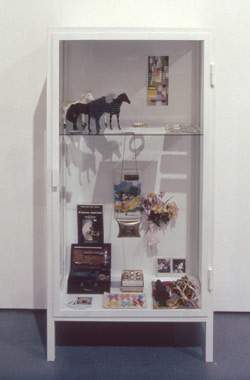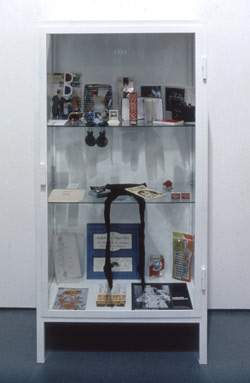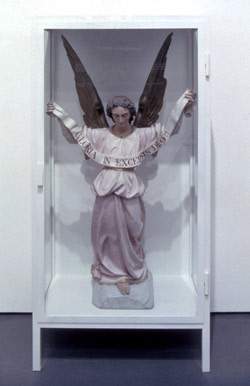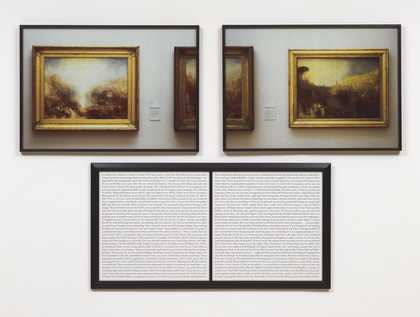
Sophie Calle, The Birthday Ceremony (Detail 1) 1998

Sophie Calle, The Birthday Ceremony (Detail 2) 1998

Sophie Calle, The Birthday Ceremony (Detail 3) 1998
Sophie Calle is fascinated by the interface between our public lives and our private selves. This has led her to investigate patterns of behaviour using techniques akin to those of a private investigator, a psychologist, or a forensic scientist. It has also led her to investigate her own behaviour so that her life, as lived and as imagined, has informed many of her most interesting works.
Calle's very first work involved following strangers around Paris. Calle had been abroad for a number of years and the idea behind this surveillance was initially an attempt to reacquaint herself with the city. However, she soon discovered that observing the behaviour and actions of these strangers provided information with which to construct their identities. Suite Venitienne, first realised in 1980, developed this idea in the form of a diary, comprising photographs and texts, detailing Calle's observations of a stranger whom she followed, in disguise, during his trip from Paris to Venice. In l’Homme au carnet of 1983 Calle elicited the active collaboration of individuals. Having found the address book of one Pierre D, Calle photocopied the contents before returning it to its owner. She then visited and interviewed the people listed, in order to build up a profile of its owner from their descriptions and anecdotes. The results were published in Liberation. At around the same time Calle herself became the willing subject of such investigations. In 1981 at Calle's request, her mother hired a private detective to follow her daughter, photograph her in secret and record her every movement. It was, in Calle's words, an attempt 'to provide photographic evidence of my own existence'.
Calle is known largely for works combining texts and photographic images in a cool presentational style; The Birthday Ceremony is her first major sculptural installation and it has been conceived especially for Art Now 14. Although made in 1998 the work has its origins in the years 1980 to 1993 when Calle invented and sustained a series of private and shared rituals around her birthday. These are now manifest as art, demonstrating how closely her life and her art are intertwined. Over this fourteen-year period, aside from the occasional year of disruption, Calle held an annual dinner party on the evening (or around the time) of her birthday. To each celebration she invited a group of friends and relatives, the precise number of invitees corresponding to the number of years of her age, with one additional, anonymous guest nominated by a chosen guest, in order to symbolise the unknown of her future. Calle initiated these dinner parties to ensure that her birthday was remembered each year. They were the most ambitious of a series of rituals Calle had invented to override an obsessive insecurity she experienced in early adulthood. The guests brought gifts, tokens of love and affection, and these Calle displayed in a glass-fronted cabinet, as a constant reminder of this affection. At the end of the year the objects were boxed up and put away, their places taken by the gifts of another birthday dinner party. At stressful moments over the years Calle was able to unpack the boxes and reassure herself of her networks of support. When she became forty in 1993, Calle realised she had been cured of this obsessive insecurity and no longer felt the necessity to recall her friendships and family ties in such a formal way.
The Birthday Ceremony brings together fifteen cabinets based on the medical design of the original, which had been given to Calle by her father. Thirteen individual cabinets and one pair, each contain the gifts of a single year. The gifts are displayed unwrapped and range from the banal to the bizarre. They include works of art, hand made tokens of affection, books and letters, junk and antiques, plastic trivia, items stolen from a restaurant, bottles of wine, chocolates and so on. Encased behind glass they become objects of magnetic desire and frustration to the viewer, who cannot hold, cannot taste, cannot unwrap. On the glass of each cabinet is a list of items. The donors themselves are not always named and it is therefore often impossible to tell if the works of art were given by the artists themselves (probable in the case of Christian Boltanski or Annette Messager, improbable in the case of the late Yves Klein). In some cases it is easy to identify a donor. Calle's mother is clearly responsible for the sensible and substantial gifts of domestic equipment that arrive each year - deliberately too large to display behind glass -and which are represented by the manufacturer's warranty. In other cases a particular theme emerges over time: someone often gives hats, another is interested in bull-fighting ephemera. On occasions, most notably with the fabulous painted-wood angel received on her fortieth birthday, guests join together to share a gift.
Calle first explored this ritual in a photographic work depicting the cabinet and its contents, reducing the annual ceremony and its associated objects to a series of documentary records. The development of the subject and its realisation as a series of installations, creates a work that is both more poignant and more perplexing. The Birthday Ceremony draws our attention to the way in which we construct our identity around secret rituals (from forms of self- indulgence to forms of self-denial) and surround ourselves with objects and activities that give meaning and substance to both our private and our public lives. In transforming personal ritual into public display, The Birthday Ceremony also raises questions about the meaning of these objects, each one removed from its customary realm. Each one is evidence of a relationship and a transaction of a particular kind and they are laid out here according to criteria that have nothing to do with traditional museum techniques of classification or display.
Text written by Frances Morris
Biography
Born 1953. Lives and works in Malakoff.

